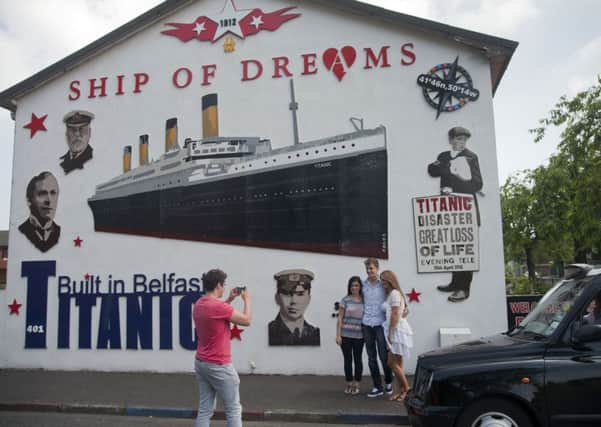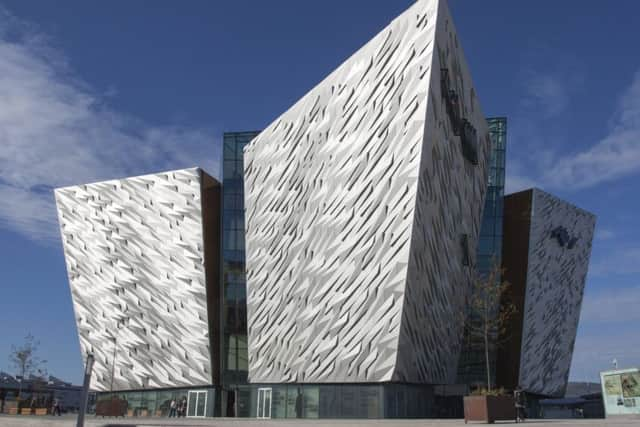Travel: How Belfast has gone from no-go to must-see
This article contains affiliate links. We may earn a small commission on items purchased through this article, but that does not affect our editorial judgement.


SCALING giant crisps sold Belfast to my five-year-old son. The outsized Skips in question were, in fact, curved metal platforms linked by a series of wires that formed an ingenious climbing frame within the interactive-tastic science and discovery centre, W5, at the city’s Odyssey complex.
I said to my boy that his crisp clambering could be considered a metaphor for our enthralling jaunt to Belfast: in that, no matter how much we snacked on the place’s attractions, we had the means and desire to nibble on more. “What’s a metaphor, dad?” he replied.
Advertisement
Hide AdAdvertisement
Hide AdAny terrific trip is helped by a great start and end, and that was provided by our Cairnryan to Larne ferry crossing courtesy of P&O. Allowing us to travel in our own car, it afforded the opportunity to journey up through the glorious greenery of the coastal route to the Giant’s Causeway at the northern tip of the island.


The bedevilling volcanic crust formation, that demands and rewards exploration, was likened to strung-together stone bubbles by my nine-year-old daughter. My weans like their descriptions. They also like watching films in transit. And our two-hour ferry crossing proved a breeze not just because we had access to the serenely relaxing Club Lounge but because movies were provided in a children’s room.
The reinvention of Belfast from the days when it was riven by what were euphemistically referred to as the Troubles is one of those marvels universally remarked upon. Rightly so. In the two decades of “normalisation”, as one tour guide put it, that curious thing has happened that always does in former no-go places: part of what made them off the tourist trail is precisely what now provides fascination to visit. That is true of the murals in the nationalist and unionist areas of the city. It was heartening to see in the republican Falls Road district that wall space is given over to the plight of refugees and injustices beyond these isles. I can’t comment on what’s going down in the loyalist Shankhill area. A massive Orange parade put that part of the city out of bounds for us on the day we took a bus tour.
I know that the Titanic exhibition is the jewel in the visitor attraction crown of Belfast. Much as that was an eminently worthwhile experience and superbly put together, our morning in Crumlin Road Gaol was unbeatable for an assault on all senses. It was harrowing, moving and fascinating. A tour is a must, and in Harry we had a gold standard guide. In use for 150 years before it closed in 1996, after a refurbishment, and a bit of “sanitising” according to Harry, it opened to the public three years ago. My family must have a streak of the macabre because we are suckers for a prison. Yet, Crumlin is so much more. It is elevated because through it you can distil both Irish history and the entire British penal system. Practically every major current politician in the north spent some time there. That the fissures between the two communities can still seep to the surface and bring paralysis in government meant that when Harry explained how First Minister Peter Robinson had been detained for a short time in the establishment, he had to add the caveat “well, currently resigned First Minister”.
It is quite incredible to think of Crumlin housing both republican and loyalist paramilitaries in the same wing; of persons in the early 1970s being detained without trial and the bomb and rocket launcher attacks that meant it wasn’t fit for purpose. Amusing to learn that, once they separated republican and loyalist prisoners into different wings, a third wing was given over to ODC – ordinary decent criminals – who could be anything from robbers to murderers.
Crumlin’s design is that of several Victorian prisons across the British Isles, including Barlinnie and Pentonville. The state executed 17 people within it, and the give-you-the-willies-but-somehow-mesmerising hanging chamber is included in your tour. My two offspring were agog, my daughter having recovered her composure after Harry had opened up with the fact that, in the early days, ten-year-olds who stole bread merely to survive were treated as “only one level up from rats” and incarcerated there.
Even if this city didn’t have such treasures as Belfast Museum, one of the most child-embracing museums I have been fortunate enough to visit, or a great castle, or amazing hilltop vistas, or the Clayton Hotel with a corking swimming pool, all of which it does, it would be worth a visit for Crumlin alone. As a post-modern attraction, it will shortly be hosting Halloween parties – with that hangman’s noose freakily backlit, I can just imagine. And recently it played host to a live show by a Johnny Cash tribute act.
Even without Crumlin, Belfast would have wowed me because it genuinely delivers on the friendly city reputation. As a Glaswegian and regular Dublin visitor over the years, I have always felt the great hospitality of these two cities is overplayed. Not so Belfast. I can honestly say that the service we enjoyed was, without fail, characterised by warmth. One explanation for that was forwarded by garrulous Uncle Jim, owner of fabled old-fashioned sweet shop Auntie Sandra’s Candy Factory. A place where you feel your fillings disintegrating just by gazing on jar upon jar of refined sugar, and a place that, over this month, will hand-make 170,000 toffee apples.
Advertisement
Hide AdAdvertisement
Hide AdPeople were helpful to a fault, he said, because “for so many years no-one wanted to come here that, now they do, we are just so happy to see them”. For the visitor, it is a genuinely happy place to be.
• Clayton Hotel Belfast, 22 Ormeau Avenue, Belfast BT2 8HS (028 9032 8511, www.claytonhotelbelfast.com). Prices start from £99 but vary according to availability so check website.
• P&O Ferries operate the shortest, fastest, most frequent crossings between Scotland and Northern Ireland, with up to seven sailings a day and a journey time of two hours on the Cairnryan to Larne route. Fares start from £74 for a car and driver.
• Upgrade to Club Lounge with complimentary newspapers and magazines and refreshments, at £12pp (booked in advance), £14pp booked on board. The children’s entertainment room has a play area and a video screen and for older children there is an arcade room. In summer, the Junior Crew Kids Club entertains five to 11-year-olds on selected sailings with face painting, puzzles and games. For further information visit POFerries.com